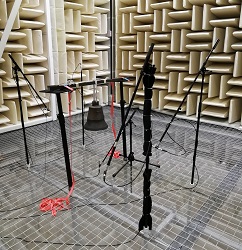
In the field of experimental vibroacoustics, it is essential to understand the dynamical behavior of structures under various excitations. Analyzing the measured data helps to get an impression of the dynamical response and helps to understand the problem at hand. For this purpose, the Chair of Vibroacoustics of Vehicles and Machines utilizes well-known approaches such as the experimental modal analysis and more recent developments, e.g. operational modal analysis. Furthermore, post-processing the data in time domain and frequency domain gives insight into different aspects of experimental investigations.
Here, we are presenting two examples. The first one is the measurement of the sound of a bell inside an anechoic chamber. The bell is excited by an impulse hammer which is capable of measuring the impact force. The structural and acoustical response, i.e. the free vibration, is measured using accelerometers and a number of microphones, respectively. Based on the data, an experimental modal analysis can be conducted in order to validate a numerical model, e.g. a finite element model. By comparing the results of the measurements with the simulation results, it is possible to update the parameters of the numerical model as well as determining the modal damping values at different resonance frequencies. In addition, we can characterize the amount of energy dissipated by sound radiation.
The second example is concerned with the measurement of structural vibrations of a MRI scanner. Since the strong magnet fields do not allow to attach measurement equipment to the structure, only non-contacting measurement techniques can be used. In this case, we used our 3D laser scanning vibrometer to measure the surface velocity of this rather large structure and analyze its vibration. Based on this data, it is possible to estimate the sound radiation of the MRI scanner and to improve imaging algorithms.